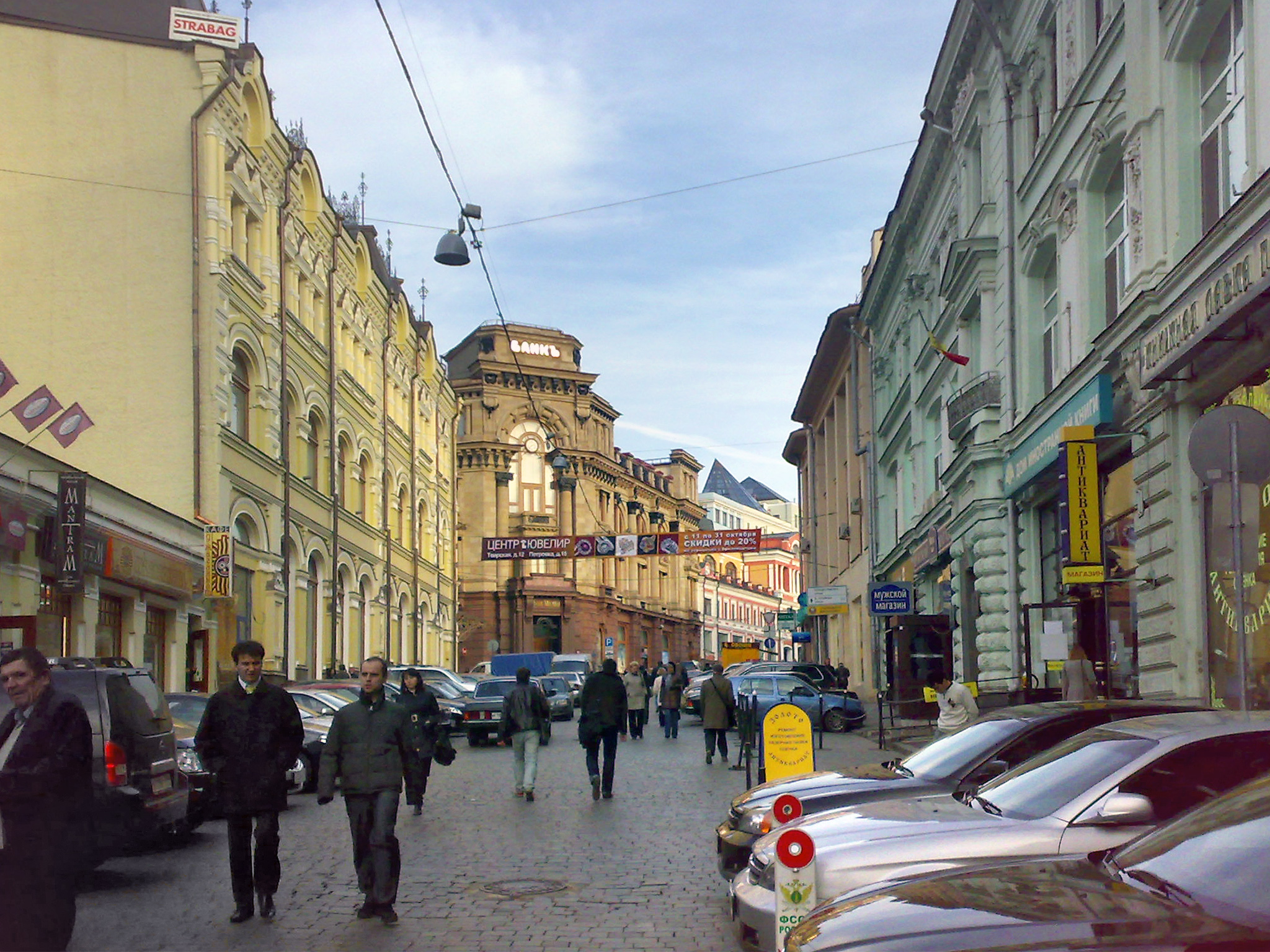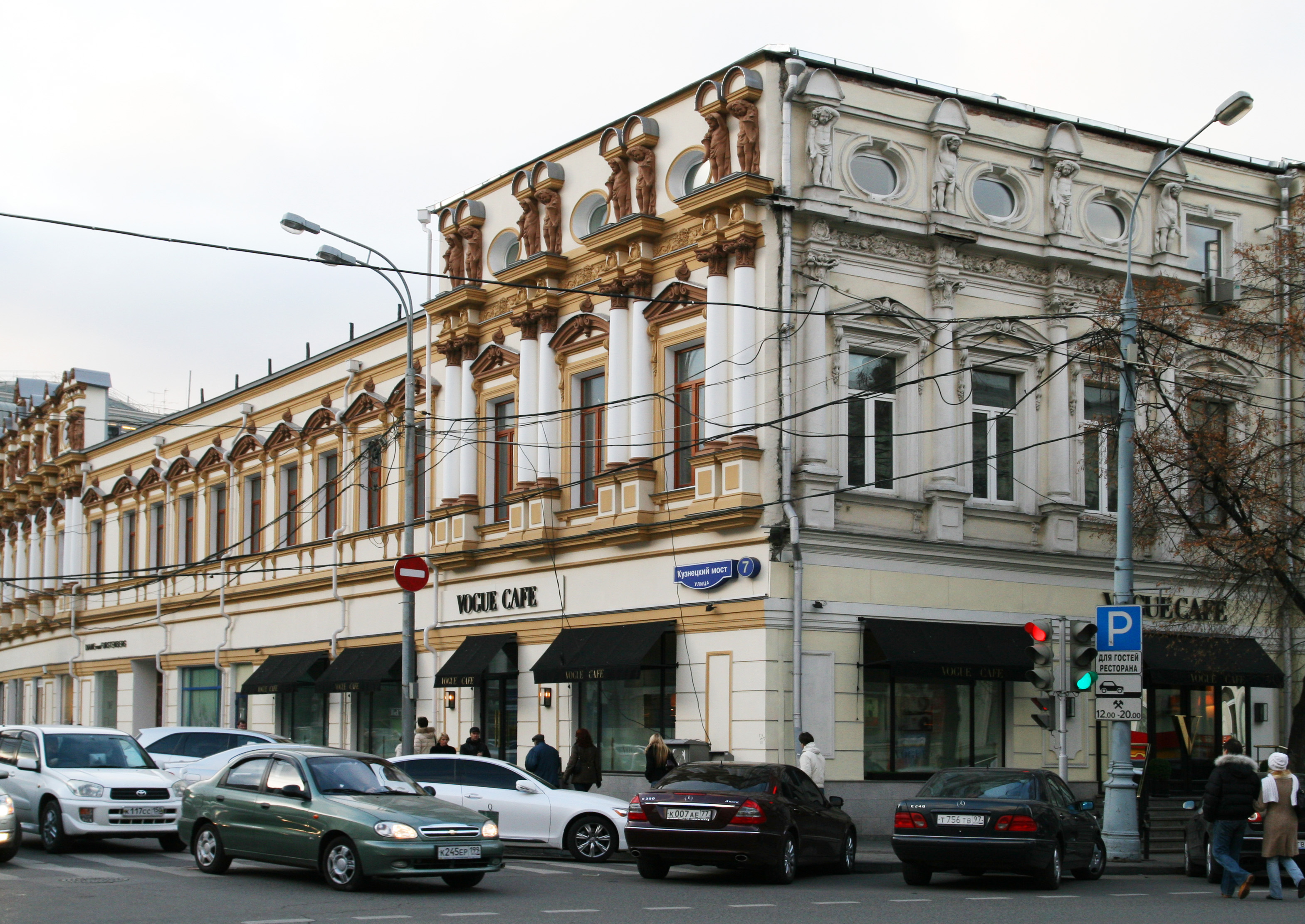Kuznetsky Bridge on:
[Wikipedia]
[Google]
[Amazon]

 Kuznetsky Most ( rus, Кузне́цкий Мост, p=kʊˈzʲnʲet͡skʲɪj ˈmost) is a street in central
Kuznetsky Most ( rus, Кузне́цкий Мост, p=kʊˈzʲnʲet͡skʲɪj ˈmost) is a street in central
 Until the end of 15th century, Moscow was growing eastward, into
Until the end of 15th century, Moscow was growing eastward, into
 The
The
File:Vasnetsov Pushechno-Liteyny dvor.jpg, Kuznetsky Most and Cannon yard in the 16th century. Reconstruction by A. Vasnetsov
File:Kuz most 18v.jpg, Kuznetsky Most in the 18th century.
File:Kuz most-1834.jpg, Kuznetsky Most in 1834
File:Kuz most-1834-2.jpg, Kuznetsky Most in the middle of 19th century
File:Kuzneckij most-11.jpg, Kuznetsky Most, a view to side of the street Lubyanka, the end of the 19th century
File:Kuz most 25.jpg, Kuznetsky Most. A view from the street Neglinnaya to side of the street Petrovka the end of the 19th century
File:Kuz most-7.jpg, Kuznetsky Most. A view from the street Petrovka to side of the street Rozhdestvenka, 1912
File:Kuz most 39 perekrestok-Rojdestvenki.jpg, Kuznetsky Most. A view from the street Rozhdestvenka to side of the street Lubyanka, the beginning of the 1930s
File:Кузнецкий пост после пересечения с Петровкой (Moscow clad in snow).jpg, Kuznetsky Most in 1908
File:Mezhdunarodnaya Kniga letter to Anthropological Society of Bombay 1932.jpg, alt=Letter by Mezhdunarodnaya Kniga (18, Kuznetsky Most) to Anthropological Society of Bombay, India, 1932., Letter by Mezhdunarodnaya Kniga (18, Kuznetsky Most) to Anthropological Society of Bombay, India, 1932.

 Kuznetsky Most ( rus, Кузне́цкий Мост, p=kʊˈzʲnʲet͡skʲɪj ˈmost) is a street in central
Kuznetsky Most ( rus, Кузне́цкий Мост, p=kʊˈzʲnʲet͡skʲɪj ˈmost) is a street in central Moscow
Moscow is the Capital city, capital and List of cities and towns in Russia by population, largest city of Russia, standing on the Moskva (river), Moskva River in Central Russia. It has a population estimated at over 13 million residents with ...
, that runs from Bolshaya Dmitrovka Street
Bolshaya Dmitrovka Street is a street located in Tverskoy District of Moscow. It runs from Okhotny Ryad (street), Okhotny Ryad to Strastnoy Boulevard. The numbering of houses is carried out from Okhotny Ryad.
Etymology
The name has been known si ...
to Lubyanka Street. The name, literally ''Blacksmith's Bridge'', refers to the 18th-century bridge over the (now underground) Neglinnaya River
The Neglinnaya ( rus, Неглинная, p=nʲɪˈɡlʲinːəjə), also known as Neglinka, Neglinna, Neglimna (Неглинка, Неглинна, Неглимна), is a 7.5 km underground river in the central part of Moscow and a tributar ...
, and a nearby foundry and the settlement of its workers. The street is administered by Tverskoy District
Tverskoy District ( rus, Тверской район, p=tvʲɪrˈskoj, a=Ru-Тверской.ogg) is a administrative divisions of Moscow, district of Central Administrative Okrug of the federal cities of Russia, federal city of Moscow, Russia. P ...
(west) and Meshchansky District
Meshchansky District () is a district of Central Administrative Okrug of the federal city of Moscow, Russia. Population:
The district extends due north from Kitai-gorod to Kamer-Kollezhsky Val. Western boundary with Tverskoy District fol ...
(east).
History
Early history
Kitai-gorod
Kitay-gorod (, ), also referred to as the Great Possad () in the 16th and 17th centuries, is a cultural and historical area within the central part of Moscow in Russia, defined by the remnants of now almost entirely razed fortifications, narro ...
. Prince Ivan III of Russia
Ivan III Vasilyevich (; 22 January 1440 – 27 October 1505), also known as Ivan the Great, was Grand Prince of Moscow and Sovereign of all Russia, all Russia from 1462 until his death in 1505. Ivan served as the co-ruler and regent for his bli ...
established his arsenal (Пушечный двор, Cannon Court) in the west, beyond the Neglinnaya river. Later, he also set up a settlement of former Pskov
Pskov ( rus, Псков, a=Ru-Псков.oga, p=psˈkof; see also Names of Pskov in different languages, names in other languages) is a types of inhabited localities in Russia, city in northwestern Russia and the administrative center of Pskov O ...
residents, abducted from their hometown after the wars of the 1480s. Population grew slowly until the 1737 fire which razed the area.
The Bridge
Soon after the fire, the territory was built out. Large territories north from the street were consolidated by theVorontsov
The House of Vorontsov (), also Woroncow and de Woroncow-Wojtkowicz, is the name of a Russian noble family whose members attained the dignity of Counts of the Holy Roman Empire in 1744 and became Princes of the Russian Empire on 6 April 1845 ...
family estate. In 1754-57, architect Semyon Yakovlev built a stone bridge over Neglinnaya River to a design by Dmitry Ukhtomsky. The bridge over Neglinnaya lowlands extended 120 meters long and 12 meters wide; the shops between Kuznetsky Bridge and Vorontsov lands were literally standing on the edge of this bridge. The street was known as the home of notorious Darya Saltykova (1730-1801), condemned to life in prison for torturing her slaves.
19th century
 The
The Fire of Moscow (1812)
During the French occupation of Moscow, a fire persisted from 14 to 18 September 1812 and all but destroyed the city. The Russian Empire, Russian troops and most of the remaining civilians had abandoned the city on 14 September 1812 just ahe ...
spared Kuznetsky Most, where Napoleon
Napoleon Bonaparte (born Napoleone di Buonaparte; 15 August 1769 – 5 May 1821), later known by his regnal name Napoleon I, was a French general and statesman who rose to prominence during the French Revolution and led Military career ...
's Guards were stationed in defense of the French colony in Moscow. In 1817-1819, the city locked the Neglinnaya River in a tunnel and demolished the redundant bridge - excluding its northern wall that supported surviving buildings. ''Kuznetsky Most'' became the symbol of French influence on Russians, immortalized in Woe from Wit
''Woe from Wit'' (, also translated as "The Woes of Wit", "Wit Works Woe", ''Wit's End'', and so forth) is Alexander Griboyedov's comedy in verse, satirizing the society of post-Napoleonic Moscow, or, as a high official in the play styled it, "a ...
by Alexandr Griboyedov
Alexander Sergeyevich Griboyedov (; 15 January 179511 February 1829) was a Russian diplomat, playwright, poet, and composer. His one notable work is the 1823 verse comedy '' Woe from Wit''. He was Russia's ambassador to Qajar Persia, where he and ...
.
After Emancipation reform of 1861
The emancipation reform of 1861 in Russia, also known as the Edict of Emancipation of Russia, ( – "peasants' reform of 1861") was the first and most important of the liberal reforms enacted during the reign of Emperor Alexander II of Russia. T ...
, Kuznetsky Most became the financial center of Moscow, with historical Juncker Bank Building and Dzhamgarov Bank built in the 1890s. Art Nouveau
Art Nouveau ( ; ; ), Jugendstil and Sezessionstil in German, is an international style of art, architecture, and applied art, especially the decorative arts. It was often inspired by natural forms such as the sinuous curves of plants and ...
landmark by Ivan Mashkov
Ivan Pavlovich Mashkov (, 13 January 1867 – 13 August 1945) was a Russian architect and preservationist, known for surveying and restoring buildings such as the Dormition Cathedral, Moscow, Dormition Cathedral in the Moscow Kremlin, Novodevichy ...
, the ''Sokol'' building (3, Kuznetsky Most) was built in 1903–1904. However, at that time its address was Kuznetsky Lane: the part of Kuznetsky Most west of Petrovka Street
Petrovka Street () is a street in Moscow, Russia, that runs north from Kuznetsky Most and Theatre Square (Moscow), Theatral Square up past Strastnoy Boulevard and Petrovsky Boulevard.
The street takes its name from the Vysokopetrovsky Monast ...
was then known as Kuznetsky Lane; two streets were merged only in 1922.
Modern history
In the 1920s, theBolshevik
The Bolsheviks, led by Vladimir Lenin, were a radical Faction (political), faction of the Marxist Russian Social Democratic Labour Party (RSDLP) which split with the Mensheviks at the 2nd Congress of the Russian Social Democratic Labour Party, ...
administration demolished the church on the corner of Kuznetsky Most and Lubyanka Street, creating Vorovsky Square. Nearby blocks were gradually converted to KGB
The Committee for State Security (, ), abbreviated as KGB (, ; ) was the main security agency of the Soviet Union from 1954 to 1991. It was the direct successor of preceding Soviet secret police agencies including the Cheka, Joint State Polit ...
offices after World War II
World War II or the Second World War (1 September 1939 – 2 September 1945) was a World war, global conflict between two coalitions: the Allies of World War II, Allies and the Axis powers. World War II by country, Nearly all of the wo ...
; the blocks facing Lubyanka Square were torn down to make way for the Ministry of the Maritime Fleet
The Ministry of the Maritime Fleet (), usually abbreviated () and also MMF, was a government ministry in the Soviet Union.
The Merchant Maritime Fleet of the USSR is abbreviated (). All Soviet merchant fleet organizations and establishments we ...
and Alexey Dushkin
Alexey Nikolayevich Dushkin (; 24 December 1904 – 8 October 1977) was a Soviet architect, best known for his 1930s designs of the Kropotkinskaya and Mayakovskaya stations of the Moscow Metro. He worked primarily for subway and railroads a ...
's Detsky Mir
Children's World () or Detsky Mir is a Russian children's retailer. Founded in June 1957, as of March 2022, the company had 1125 stores. It is the largest children's goods retailer in Russia and the CIS, with the retail chain in Russia, as well ...
department store. The latter was restored in 2014 and now hosts the world's largest mechanical clock, "Raketa
Raketa ( rus, Ракета, p=rɐˈkʲɛtə, "Rocket") is a brand of wristwatches that have been manufactured since 1961 by the Petrodvorets Watch Factory in Saint Petersburg. The Petrodvorets Watch Factory is Russia's oldest factory, founded by ...
Monumental".
Rapid transit
Kuznetsky Most
Kuznetsky Most ( rus, Кузне́цкий Мост, p=kʊˈzʲnʲet͡skʲɪj ˈmost) is a street in central Moscow, that runs from Bolshaya Dmitrovka Street to Lubyanka Street. The name, literally ''Blacksmith's Bridge'', refers to the 18th-c ...
, Lubyanka and Okhotny Ryad stations of the Moscow Metro
The Moscow Metro) is a rapid transit system in the Moscow Oblast of Russia. It serves the capital city of Moscow and the neighbouring cities of Krasnogorsk, Moscow Oblast, Krasnogorsk, Reutov, Lyubertsy, and Kotelniki. Opened in 1935 with one l ...
are located nearby.
Gallery
References
* Russian: П.В.Сытин, "Из истории московских улиц", М, 1948 (Sytin) {{coord, 55, 45, 42, N, 37, 37, 12, E, region:RU_type:landmark_source:kolossus-ruwiki, display=title Shopping districts and streets in Russia Streets in Moscow Tourist attractions in Moscow